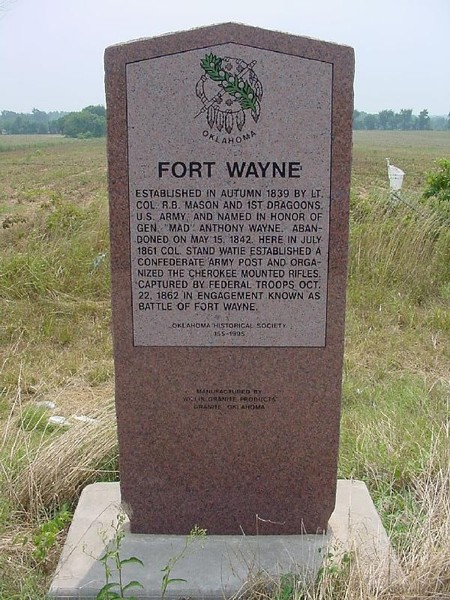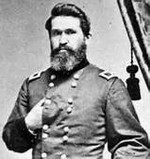Battle of Old Fort Wayne
Introduction
Text-to-speech Audio
Images
Col. Stand Watie established a Confederate army post and organized the Cherokee Mounted Rifles in the Battle of Old Fort Wayne.

The Battle of Old Fort Wayne [Battle of Maysville] was fought in Delaware County, Oklahoma; then part of the Indian Territory, on October 22nd 1862.
![The Battle of Old Fort Wayne [Battle of Maysville] was fought in Delaware County, Oklahoma; then part of the Indian Territory, on October 22nd 1862.](https://storage.googleapis.com/clio-images/medium_23517.51652.jpg)
Bridadier General James G. Blunt attacked overran Cooper's troops, who made a speedy retreat. They fled so quickly they left behind their artillery and equipment.

Backstory and Context
Text-to-speech Audio
The Battle of Old Fort Wayne has been identified by several names. “Other names include the Battle of Maysville, Battle of Beatties’ Prairie or Beaty’s Prairie.”¹ The two opposing commanders were Brigadier General James G. Blunt for the Union Army and Colonel Douglas H. Cooper for the Confederate Army. On October 22, 1862, Union general Blunt and his force of 5000 men came upon Colonel Cooper’s force camped near Old Fort Wayne. It was thought that Colonel Douglas’s force consisted of 5000 to 7000 troops, but in reality he is force was substantially smaller. Nevertheless, Blunt attacked Cooper’s forces. Coper’s Confederate forces were overrun and made a speedy retreat. They had to flee so quickly that they had left their artillery and other needed equipment behind.
On October 4, 1862, Colonel Cooper and the Confederate forces had to make a retreat from Newtonian because they could no longer repel the much larger Union Army. Cooper’s forces marched to Old Fort Wayne which was just inside the Indian Territory, now Oklahoma. Colonel Cooper was now on a mission to enlist more men to build up his army so he could organize an invasion into Kansas. Cooper recruited for several weeks to enlarge his members. It was reported that Cooper’s forces included a force of Choctaws, Chickasaws, and Lower Creeks. The Union scouts had reported that Cooper’s Confederate force total about 7000 men, but in reality he only had about 1500. “Blunt’s Union troops numbered 3500 men who were better trained and better equipped than the recently raised Confederate units.” ¹
Blunt was anxious to surprise the Confederate troops who were unsuspecting of the advancing Union troops. Blunt left a portion of his men behind to rest before they were to follow. On October 22, 1862 around 5:00am, Blunt’s men encountered Confederate pickets at Maysville. The pickets were stationed to watch out for the opposing enemy. “Blunt follow the pickets a few miles until they came upon Cooper’s main Confederate battle line.” ¹ Even though Blunt thought he was outnumbered, he still decided to attack with the three companies of infantry that accompanied him on his reconnaissance expeditions. “A timely arrival of federal reinforcements from Blunt’s main columnn saved him from disaster.”²
“Although the Confederates put up stiff resistance for a half hour, the overwhelming numbers forced them to retreat.” ³ The Confederates retreated with such haste, they left their artillery and equipment on the battlefield. The Union troops pursued Cooper’s forces almost seven miles before calling off the chase. It was reported that the Rebel troops withdrew 70 miles to Fort Gibson on the Arkansas River. The Union victory was a setback for the Confederate offensive. 4 The Union Army’s casualties were 14 and the Confederate armies were 150. 4
A commemorative marker has been placed in Benton County, Arkansas at the northwest corner of the state route 43 and 72 in Maysville.
